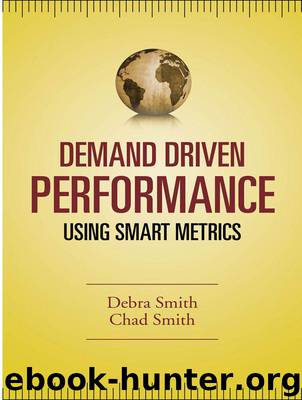Demand Driven Performance by Debra Smith & Chad Smith

Author:Debra Smith & Chad Smith [Smith, Debra]
Language: eng
Format: mobi
Tags: -
Publisher: McGraw-Hill Professional
Published: 2013-11-11T14:00:00+00:00
The Emphasis on GAAP and the Rise of Unfocused Improvement and Outsourcing
As previously discussed in Chap. 3, the nail in the coffin for providing variable costing information arrived in the early ’80s with the widespread adoption of MRP II and its ability to automatically roll up all manufacturing costs into one top-level number. Unfortunately, that number is a fully absorbed unit cost and it is being used inappropriately at all levels of the organization to drive decisions that are at best suboptimal and at worst disastrous.
The deep truth of cost-centric efficiency is at the core of both companies’ outsourcing decisions and local cost efficiency improvement actions and projects. Companies believe in a linear, Newtonian view of the world. Every efficiency gain, anywhere, translates to an increase in system productivity because Newtonian math is additive. Additive math works only for an independent or single-event system. An efficiency gain at any one resource translates to an increase in system speed but does not change the rate of output (governed by the slowest unit) or the truly variable cost of producing any product. Maximizing local efficiencies does not maximize system efficiency. Carnegie, DuPont, Ford, and Brown understood this. Unitizing a fixed cost never entered their paradigm. There were no incentives to artificially build inventory. They were solidly focused on flow-centric efficiency and ROI.
Unfortunately companies act as if they believe that GAAP standard absorption unit cost is a true representation of cash flow. The assigned standard fixed dollar cost rate, coupled with our Newtonian view of the world leads managers to believe that every resource minute saved anywhere is the equivalent of a dollar cost savings to the company. GAAP unit costs are used to estimate both cost improvement opportunities and cost savings for batching decisions, improvement initiatives, and capital acquisition justifications. In reality the cost being saved has no relationship to cash expended or generated and will not result in ROI gains of the magnitude reported. Cost savings are being grossly overstated. Today it is not uncommon to find plants running with burden rates over 1000 percent.10 Unfocused machine or labor efficiencies are meaningless and even counterproductive. They are completely overstated through the use of GAAP absorption unit costing. A decrease in fixed costs will simply not happen due to a time savings at any single resource area. The total fixed cost spend will remain the same, regardless of what the unit fixed cost does.
Previous efforts of the 1920s through today, to reduce direct labor, have been incredibly successful. The ratio of labor dollars to overhead investment dollars, as a percent of product cost has totally flipped since the turn of the twentieth century. Touch time labor today averages less than 7% of the product cycle time (meaning parts and product are waiting to be worked on 93% of the time) and direct labor accounts for less than 10% of total product cost in most manufacturing organizations. The opportunity for supply chains is not labor or machinery productivity gains but to focus on getting rid of the “wait time” that impedes flow.
Download
This site does not store any files on its server. We only index and link to content provided by other sites. Please contact the content providers to delete copyright contents if any and email us, we'll remove relevant links or contents immediately.
| Automotive | Engineering |
| Transportation |
Whiskies Galore by Ian Buxton(41515)
Introduction to Aircraft Design (Cambridge Aerospace Series) by John P. Fielding(32876)
Small Unmanned Fixed-wing Aircraft Design by Andrew J. Keane Andras Sobester James P. Scanlan & András Sóbester & James P. Scanlan(32560)
Craft Beer for the Homebrewer by Michael Agnew(17920)
Turbulence by E. J. Noyes(7684)
The Complete Stick Figure Physics Tutorials by Allen Sarah(7128)
Kaplan MCAT General Chemistry Review by Kaplan(6576)
The Thirst by Nesbo Jo(6425)
Bad Blood by John Carreyrou(6264)
Modelling of Convective Heat and Mass Transfer in Rotating Flows by Igor V. Shevchuk(6216)
Learning SQL by Alan Beaulieu(6018)
Weapons of Math Destruction by Cathy O'Neil(5809)
Man-made Catastrophes and Risk Information Concealment by Dmitry Chernov & Didier Sornette(5634)
Digital Minimalism by Cal Newport;(5366)
Life 3.0: Being Human in the Age of Artificial Intelligence by Tegmark Max(5169)
iGen by Jean M. Twenge(5145)
Secrets of Antigravity Propulsion: Tesla, UFOs, and Classified Aerospace Technology by Ph.D. Paul A. Laviolette(4966)
Design of Trajectory Optimization Approach for Space Maneuver Vehicle Skip Entry Problems by Runqi Chai & Al Savvaris & Antonios Tsourdos & Senchun Chai(4833)
Electronic Devices & Circuits by Jacob Millman & Christos C. Halkias(4731)
